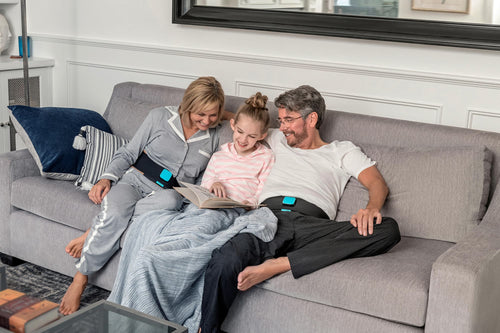From long-distance, solo backpacking adventures in the mountains to family day hikes on local trails, walking is great for the mind and the body. Here are the reasons why you should start walking more, plus all the tips and kit lists you need to stay dry, cool and comfortable when exploring the outdoors.
How does regular walking burn fat and improve fitness?
Walking regularly offers a wide host of health benefits from lowering your body fat percentage (BFP) to improving your metabolic efficiency.
Author Kyle Boelte measured the effects that one month of trekking had on his body, hiking the 486-mile Colorado Trail from Denver to Durango (originally published in Outside Magazine).
In 29 days Kyle reduced his body fat percentage from 13% to 5%, lowered his resting heart rate from 48 BPM to 40 BPM by improving his aerobic fitness and, most impressively, transformed himself into a “fat-burning machine.”
Before the thru-hike, Kyle was burning 66% fat and 34% carbs during low-intensity exercise. After, he completely shifted that balance to an incredible 91% fat and 9% carbs.
Notably, Kyle also chose a lower-carb diet than most long-distance hikers: “On the Colorado Trail, we stuck to nuts, jerky, dried fruit and only one carb-heavy meal per day, like a mac-and-cheese dinner.”
You don’t need to complete an epic trek to feel the benefits of walking
Whether it’s a day of hillwalking in the countryside, commuting on foot or simply going for a stroll on your lunch break, walking regularly is great for boosting metabolism, as well as refreshing your mind.
We also recommend using your Slendertone abs belt during low-intensity walks. Clinical studies have concluded that walking when toning can help enhance waist size reduction results (Anderson, 2006).
This is because those tummy-tightening core and abdominal muscles are being worked much harder.
How can I improve comfort and enjoyment on every adventure?
Footwear is the foundation of any outdoor adventure
For summer walks and hikes on well-maintained paths, choose trail shoes or light walking boots with a flexible sole and breathable upper.
Winter walks need more protection and water resistance (full-grain leather uppers are the hardiest).
For walks on more rugged terrain or hikes where you’ll be carrying a heavy backpack, choose walking boots with stiffer soles and higher cuffs for more foot and ankle support.
Whatever the season or adventure, your outdoor footwear needs deep lugs (for traction in the mud) and/or a textured rubber sole (which is stickier on rock).
For the best fit ensure that there is some space for your toes at the front (feet expand during walks). Your heels must be anchored into the heel cups too – if they slide up and down you may get blisters.
Technical walking socks make a big difference too. They offer more padding on the heel and forefoot and wick away sweat, to keep feet drier and minimise chafing or blisters.
Use a layering system to stay dry, cool and comfortable
For most walks your ‘layering system’ includes a base layer, mid-layer or fleece and waterproof shell.
These layers all work together to block out the elements and allow sweat and heat vapour to escape. They also make it easy to regulate your body temperature.
Base layers (made from either wool, synthetic fibres or both) wick sweat away from the skin to keep you dry. These are much more effective than a cotton T-shirt.
Your mid-layer or fleece traps a layer of warmth for insulation and continues to transport sweat and heat to the outside.
Waterproofs block out the elements and allow sweat to escape your layering system so that you stay dry and comfortable. Not all waterproofs are windproof though, so always check the technical specs.
Fit your backpack perfectly to improve posture and comfort
Whatever your height or body type, these are some golden rules for evenly distributing pack weight.
- First, ensure the pack is the right size for your back length (the waistline to the 7th cervical).
- Ensure the hip belt sits snugly on top of the hip bones. Your hips should be carrying most of the weight and take it away from your spine and shoulders.
- Tighten the shoulder straps to bring the weight closer to your body and improve stability.
- Tighten the chest strap to pull in the shoulder straps and give your arms maximum mobility.
- Large packs also have load lifter straps for better pack stability. Tighten these to 45° angles.
Walking kit list
These are the basics you need for a day walk in the hills or the countryside:
- Day pack or backpack
- Walking boots or trail shoes
- Walking socks
- Base layer
- Mid-layer or fleece
- Waterproof jacket
- Waterproof trousers
- Insulating jacket (down or synthetic)
- Warm hat (the summit can be chilly, even on summer walks)
- Hydration bladder or water bottle
- Head torch (with spare batteries)
- Map and compass (never rely solely on GPS devices to navigate)
- First aid kit
Camping kit list
Add these essentials to your checklist if you’re camping overnight:
- Tent
- Sleeping bag
- Inflatable sleeping mat (with puncture repair kit)
- Cooking stove and pot
- Cooking utensils (mug, fork, knife and spoon)
- Purification tablets or water filter
Keep safe and never take risks in the outdoors
Always pack your first aid kit, head torch (with spare batteries) and down jacket, just in case you find yourself outside longer than planned.
If you need help or training, hire an experienced mountain guide or take courses to brush up on your bushcraft and navigation skills.


